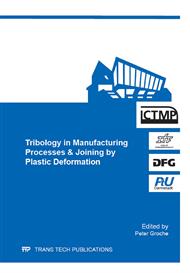[1]
Robert Pivec, Aaron J Johnson, Simon C Mears, Michael A Mont. Hip arthroplasty. Lancet 2012; 380: 1768–77. September 26, (2012).
DOI: 10.1016/s0140-6736(12)60607-2
Google Scholar
[2]
Jiri Gallo et al. Aseptic Loosening of Total Hip Arthroplasty as a Result of Local Failure of Tissue Homeostasis. Recent Advances in Arthroplasty, Dr. Samo Fokter (Ed. ), InTech. 27 January (2012).
DOI: 10.5772/25817
Google Scholar
[3]
G. Pezzotti, K. Yamamoto. Artificial hip joints: The biomaterials challenge. Journal of the Mechanical Behavior of Biomedical Materials, 6 June (2013).
Google Scholar
[4]
T. Hu et al. Wear resistance of NiTi alloy after surface mechanical attrition treatment. Surface & Coatings Technology 205 (2010) 506–510.
DOI: 10.1016/j.surfcoat.2010.07.023
Google Scholar
[5]
. A. Amanov, I-S. Cho, D-E. Kim, Y-S. Pyun. Fretting wear and friction reduction of CP titanium and Ti-6Al-4V alloy by ultrasonic nanocrystalline surface modification. Surface and coatings technology 207 (2012) 135-142.
DOI: 10.1016/j.surfcoat.2012.06.046
Google Scholar
[6]
B. Hashemi, M. Rezaee Yazdi, V. Azar. The wear and corrosion resistance of shot-peened-nitrided 316L austenitic stainless steel. Materials end Design 32 (2011) 3287-3292.
DOI: 10.1016/j.matdes.2011.02.037
Google Scholar
[7]
L.C. Zhang , E.C. S Kiat, A. Pramanik. A Briefing on the Manufacture of Hip Joint Prostheses. Advanced Materials Research Vols. 76-78 (2009) pp.212-216.
DOI: 10.4028/www.scientific.net/amr.76-78.212
Google Scholar
[8]
N.R. Tao, J. Lu, K. Lu. Surface nanocrystallization by surface mechanical attrition treatment. Materials Science Forum Vol. 579 (2008) pp.91-108.
DOI: 10.4028/www.scientific.net/msf.579.91
Google Scholar
[9]
K. Lu, J. Lu. Nanostructures surface layer on metallic materials induced by surface mechanical attrition treatment. Materials Science and Engineering A 375-377 (2004) 38-45.
DOI: 10.1016/j.msea.2003.10.261
Google Scholar
[10]
T. Hu et al. Surface hardening of NiTi shape memory alloy induced by the nanostructured layer after Surface Mechanical Attrition treatment. Journal of nanoscience and nanotechnology. Vol. 11 10954-10957, (2011).
DOI: 10.1166/jnn.2011.4062
Google Scholar
[11]
X.H. Chen, J. Lu, L. Lu, K. Lu. Tensile properties of a nanocrystalline 316L austenitic stainless steel. Scripta Materialia 52(2005) 1039-1044.
DOI: 10.1016/j.scriptamat.2005.01.023
Google Scholar
[12]
A.L. Ortiz, J-W. tian, L.L. Shaw, P.K. Liaw. Experimental study of the microstructure and stress state of shot peened and surface mechanical attrition treated nickel alloys. Scripta Materialia 62 (2010) 129-132.
DOI: 10.1016/j.scriptamat.2009.10.015
Google Scholar
[13]
L. Qin, P. Lin, Y. Zhang, G. Dong, Q. Zeng. Influence of surface wettability on the tribological properties of laser textured Co-Cr-Mo alloy in aqueous bovine serum albumin solution. Applied Surface Science (2010).
DOI: 10.1016/j.apsusc.2012.12.003
Google Scholar
[14]
V . Jardret, H. Zahouani, J.L. Loubet , T.G. Mathia. Understanding and quantification of elastic and plastic deformation during a scratch test. Wear 218(1998)8-14.
DOI: 10.1016/s0043-1648(98)00200-2
Google Scholar
[15]
D. Dowson, S. Taheri and N.C. Wallbridge. The role of counterface imperfections in the wear of polyethylene. Wear, 119 (1987) 277-293.
DOI: 10.1016/0043-1648(87)90036-6
Google Scholar
[16]
Hiroshi Ito et al. In Vivo Femoral Head Damage and Its Effect on Polyethylene Wear. The Journal of Arthroplasty Vol. 25 No. 2 (2010).
Google Scholar
[17]
V.A. González-Mora, M. Hoffmann, R. Stroosnijder, F.J. Gil. Wear tests in a hip joint simulator of different CoCrMo counterfaces on UHMWPE. Materials Science and Engineering C 29 (2009) 153–158.
DOI: 10.1016/j.msec.2008.06.006
Google Scholar


